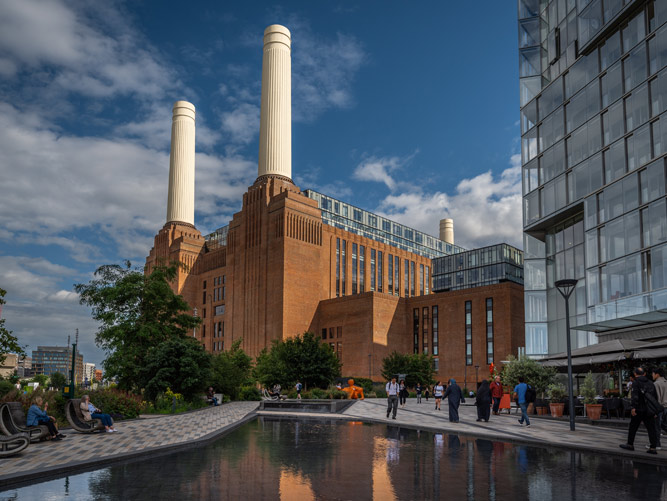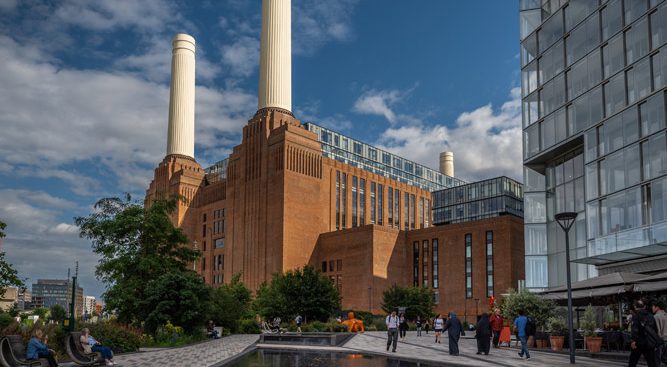Achieving Sustainability Goals: A Case Study of High-Quality Glass Solutions in Commercial Buildings
Project Overview
The Battersea Power Station Phase 3B project is a high-profile redevelopment situated in London, UK.
This ambitious scheme seeks to revitalise the iconic power station into a vibrant mixed-use development. Thornton Tomasetti served as the construction engineers, while OAG was responsible for elements of the architectural glazing design, providing their expertise to ensure the success of this landmark task. ESG Group was selected to supply and fabricate the glass panels essential for the development.
Key Project Participants
Client: Battersea Power Station Development Company
Construction Engineers: Thornton Tomasetti
Architectural Glazing Project Designers: OAG
Glass Supplier and Fabricator: ESG Group
Project Requirements and Compliance
The project necessitated the use of high-quality glass that adhered to stringent standards for safety, durability, and aesthetic appeal.
ESG Group supplied a variety of glass types, including toughened, heat-soaked, laminated, and security glass, all of which complied with relevant British and European standards.
Factory Visit and Quality Assurance
A factory visit to our facility in Witham, UK, was conducted on March 24th, 2023, by representatives from Thornton Tomasetti, OAG, and other stakeholders.
The purpose of the visit was to review the initial glass panels fabricated for the project and assess ESG’s production capabilities and quality assurance procedures.

During the visit, the team observed several key processes including:
Cutting, Drilling, and Processing: ESG handles all these processes for monolithic glass within their factory.
Heat Treatment: Toughening is performed by heating the glass to 670°C followed by quenching. ESG confirmed regular break tests to check the breakage pattern of the glass.
Laminating: ESG uses high-quality PVB from Kuraray-Trosifol, with a clean room environment to ensure optimal conditions for laminating.
Heat Soak Testing: This process involves raising the temperature of the glass to 290°C and maintaining it for four hours to greatly reduce potential nickel sulphide inclusions.
Quality Management and Standards
ESG Group adheres to the BS EN ISO 9001:2015 quality management system, ensuring consistent product quality and compliance with industry standards. Specific standards relevant to the project include:
BS EN 12150:2015: Thermally toughened soda lime silicate safety glass
BS EN 1863:2000: Heat-strengthened soda lime silicate glass
BS EN 14179:2005: Heat-soaked thermally toughened soda lime silicate safety glass
BS EN 14449:2005: Laminated glass and laminated safety glass
BS EN 356:2000: Manual attack-resistant glass
LPS 1270: Intruder-resistant security glazing units
Certificates of Conformity
ESG Group issued Certificates of Conformity to affirm that the glass products supplied for the Battersea Power Station project comply with all relevant standards and specifications. These certificates provide assurance of quality and adherence to safety norms, signed by the ESG Quality Manager.
Commitment to Sustainability
ESG Group is deeply committed to sustainability and environmental responsibility, integral aspects of their operations. Their commitment is demonstrated through:
Energy Efficiency: ESG utilises energy-efficient machinery and processes to minimise energy consumption during production. The heat treatment and laminating processes are optimised for energy efficiency, reducing the overall carbon footprint.
Waste Reduction: ESG implements rigorous waste management protocols. Offcuts and waste glass are recycled, ensuring that as much material as possible is reused. The company also focuses on reducing waste at the source by improving precision in cutting and processing.
Sustainable Materials: ESG sources raw materials from suppliers who adhere to sustainable practices. The use of high-quality, durable materials not only extends the lifespan of the glass products but also reduces the need for replacements, contributing to long-term sustainability.
Environmental Compliance: ESG complies with environmental standards such as ISO 14001, which sets out the criteria for an effective environmental management system. This compliance ensures that our operations have minimal adverse environmental impacts.
Innovation and Development: ESG is continually researching and developing new products that offer enhanced environmental benefits, such as improved safety, security and reduced energy usage for buildings.
Summary
The collaboration between Thornton Tomasetti, OAG, and ESG Group ensured that the Battersea Power Station Phase 3B project met the highest standards of quality, compliance, and sustainability.
The careful planning, rigorous quality assurance procedures, and adherence to international standards underline the project’s commitment to excellence. This redevelopment will not only preserve the historical essence of the power station but also set a benchmark for future urban regeneration projects.
By leveraging the expertise of ESG and other leading industry professionals and prioritising sustainability, the Battersea Power Station Phase 3B project is poised to become an icon of modern engineering and architectural innovation.
Ready to elevate your space?
Contact us today to start your project!




